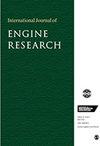Turbulent flow development within the discharge cavity of a screw compressor
IF 2.1
4区 工程技术
Q2 ENGINEERING, MECHANICAL
引用次数: 0
Abstract
Spatial flow field velocities within the discharge cavity of an optical screw compressor have been measured using LDV and PIV techniques. Angle-resolved velocities were obtained over a time window of 1° at a speed of 1000 rpm, pressure ratio of 1 and temperature of 55°C. Comparison between the LDV and PIV results showed very good agreement and provided a good level of confidence in the presented data. Overall, the flow field results revealed the presence of a complex, turbulent, 3D and vortical flow structure within the discharge cavity. LDV measurements at the exit of the discharge port showed that the inflow into the cavity has two distinct flow features that includes undulated velocity profiles with high gradient during the opening of the port, and uniform jet-like flows during the rest of the time. The energy necessary to create that jet-like flow was from the built-in pressure in the rotors. Turbulence fluctuations were high and followed the mean flow variations with values up to 35% of the mean values during the undulating flow. PIV spatial mean flow measurements showed a uniform axial flow close to bottom of cavity that has been transformed to a stable solid body vortex at the top of the cavity. These measurements within the discharge cavity are made for the first time and they are unique and in great detail that can be used for validation of CFD codes and optimisation of compressors to improve their efficiency for different system applications. Graphical abstract螺杆压缩机排气腔内紊流的发展
利用LDV和PIV技术测量了光螺杆压缩机排气腔内的空间流场速度。在转速为1000 rpm、压力比为1、温度为55℃的情况下,在1°的时间窗口内获得角分辨速度。LDV和PIV结果之间的比较显示出非常好的一致性,并为所提供的数据提供了良好的置信度。总体而言,流场结果显示出放电腔内存在复杂的湍流、三维和涡旋流结构。在排气口出口处的LDV测量结果表明,进入空腔的流入流体具有两种明显的流动特征,即在开口期间具有高梯度的波动速度分布,而在其余时间则呈均匀的射流状流动。产生这种喷流所需的能量来自旋翼内的内置压力。在波动流动中,湍流度波动较大,随平均流量变化而变化,其值高达平均值的35%。PIV空间平均流测量结果显示,在腔体顶部,靠近腔体底部的均匀轴向流已经转化为稳定的实体涡。这些测量是首次在排气腔内进行,它们是独一无二的,非常详细,可用于验证CFD代码和优化压缩机,以提高其在不同系统应用中的效率。图形抽象
本文章由计算机程序翻译,如有差异,请以英文原文为准。
求助全文
约1分钟内获得全文
求助全文
来源期刊

International Journal of Engine Research
工程技术-工程:机械
CiteScore
6.50
自引率
16.00%
发文量
130
审稿时长
>12 weeks
期刊介绍:
The International Journal of Engine Research publishes high quality papers on experimental and analytical studies of engine technology.
 求助内容:
求助内容: 应助结果提醒方式:
应助结果提醒方式:


